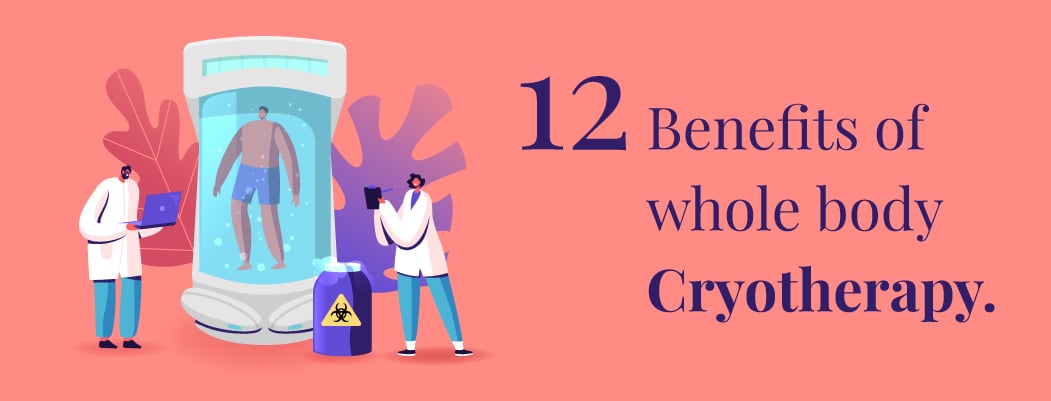How Cryotherapy Can Improve Your Health
March 3, 2025

Cryotherapy, also known as cold therapy, involves exposing the body to extremely low temperatures for a short period of time. This can be achieved through various methods, including whole-body cryotherapy, which involves standing in a chamber filled with liquid nitrogen, or local cryotherapy, which involves applying cold air or a cold compress to a specific area of the body.
During cryotherapy, the body’s surface temperature drops, which causes the blood vessels to constrict and then dilate, leading to an increased flow of oxygen-rich blood to the tissues. This process can help to reduce inflammation, improve circulation, and boost the immune system.
Why do Doctors Use Cryotherapy?
Doctors use cryotherapy as a minimally invasive therapy to remove damaged or diseased tissue caused by a range of medical conditions. Cryotherapy is usually performed without open surgery and has a fast recovery time with minimal pain. Doctors may recommend cryotherapy for conditions such as bone cancer, cervical cancer, liver cancer, prostate cancer, precancerous cells in the cervix, precancerous skin conditions, and early-stage skin cancers such as squamous cell carcinoma and basal cell carcinoma, retinoblastoma, and skin conditions like warts, skin tags, and dark spots.
Types
Cryotherapy comes in various forms, each targeting different health concerns. From localized cold treatments to full-body exposure, here are the main types of cryotherapy:
1. Whole-Body Cryotherapy (WBC)
Whole-body cryotherapy involves briefly exposing the entire body to extremely low temperatures, usually between -200°F and -300°F, for 2 to 4 minutes. This is done in a specialized chamber where liquid nitrogen or refrigerated cold air rapidly cools the environment. The therapy is commonly used to reduce muscle inflammation, improve circulation, and enhance overall recovery. Athletes and fitness enthusiasts often turn to WBC for post-workout recovery and performance enhancement.
2. Partial-Body Cryotherapy (PBC)
Similar to WBC, partial-body cryotherapy also uses a cryogenic chamber, but only the torso and lower body are exposed to the extreme cold. The head remains outside the chamber, making it a preferred choice for those who may be sensitive to full-body cold exposure. This method provides similar benefits to WBC, such as reducing muscle soreness and promoting relaxation.
3. Cold-Water Immersion (CWI)
Cold-water immersion, also known as ice bathing or cold plunging, involves submerging the body (except the head) in ice-cold water, typically below 59°F. This method has been used for centuries to alleviate muscle soreness, reduce swelling, and enhance post-exercise recovery. It is popular among athletes as a natural way to speed up healing and relieve fatigue.
4. Ice Therapy (Localized Cryotherapy)
Localized cryotherapy focuses on a specific body area using ice packs, cold compresses, or gel-based cooling devices. It is commonly used to reduce pain and swelling from injuries, post-surgical recovery, and conditions like migraines. This traditional method is widely recommended for minor injuries, as it helps constrict blood vessels and reduce inflammation.
5. Cryosurgery (Cryoablation)
Cryosurgery is a medical technique that freezes and eliminates abnormal or diseased tissue using liquid nitrogen or argon gas. It is widely used in dermatology for removing warts, skin tags, and precancerous lesions. In oncology, cryosurgery is also used to treat certain cancers, such as prostate and cervical cancer, by freezing tumor cells.
Each type of cryotherapy offers unique benefits depending on the health condition being treated. Whether it’s for athletic recovery, pain management, or medical treatments, cryotherapy continues to gain popularity as an effective wellness solution.
Tips and Guidelines
Before undergoing cryotherapy, discussing any medical conditions you want to treat with the person assisting with or administering your treatment is essential. It’s also a good idea to consult your doctor before using any type of therapy. If receiving whole-body cryotherapy, wear dry, loose-fitting clothing and bring socks and gloves to protect from frostbite. Moving around, if possible, is recommended to keep your blood flowing during therapy. If you’re getting cryosurgery, your doctor will discuss specific preparations with you beforehand, which may include not eating or drinking for 12 hours beforehand.
Health Benefits of Cryotherapy
Cryotherapy offers various health benefits by exposing the body to extreme cold, which triggers physiological responses that aid in pain relief, recovery, and overall well-being.
Reduces Inflammation
Inflammation is the body’s natural response to injury or infection, but chronic inflammation can lead to a variety of health problems, including arthritis, diabetes, and heart disease. Cryotherapy can help to reduce inflammation by decreasing the production of pro-inflammatory cytokines and increasing the production of anti-inflammatory cytokines.
Relieves Pain
Cryotherapy can be an effective treatment for pain relief. Cold temperatures can help numb the nerves, reducing pain and discomfort. Cryotherapy has been shown to be particularly effective for treating conditions such as arthritis, back pain, and muscle soreness.
Boosts the Immune System
Exposure to cold temperatures can stimulate the production of white blood cells responsible for fighting off infections and diseases. This can help to boost the immune system and reduce the risk of illness.
Enhances Athletic Performance
Cryotherapy has been shown to improve athletic performance by reducing muscle soreness and improving recovery time. Athletes who use cryotherapy after workouts have reported feeling less fatigued and having more energy.
Improves Mental Health
Cryotherapy has been shown to have a positive effect on mental health. Cold temperatures can help reduce stress and anxiety by releasing endorphins, which are natural mood-boosting chemicals.
Promotes Weight Loss
Cryotherapy has been shown to promote weight loss by increasing metabolism and burning calories. Cold temperatures can also activate brown fat, which is a type of fat that burns calories instead of storing them.
Improves Skin Health
Cryotherapy can improve skin health by increasing blood flow and oxygenation to the skin. This can help reduce the appearance of fine lines and wrinkles and improve skin tone and texture.
When to See the Doctor?
You should consult your doctor if you’re considering cryotherapy as a treatment for a medical condition. Your doctor can help determine if cryotherapy is a suitable treatment option for your condition and discuss any potential risks or side effects.
If your doctor recommends cryotherapy, they may refer you to a specialist who is trained in performing the procedure. This specialist may be a dermatologist for skin conditions, an oncologist for cancer-related conditions, or another type of doctor with expertise in cryotherapy.
It’s also essential to consult your doctor if you experience any unusual symptoms after undergoing cryo therapies, such as severe pain, bleeding, or signs of infection, as this may indicate a complication that requires medical attention.
Frequently Asked Questions
1. Is it good to do cryotherapy every day?
It is generally not recommended to do cryotherapy every day. While cryotherapy is generally considered safe, there are potential risks and side effects associated with frequent or prolonged exposure to extremely cold temperatures. Additionally, there is limited research on the long-term effects of cryotherapy. It is unclear whether daily or frequent use of cryotherapy provides any additional benefits beyond those achieved with occasional use.
If you are considering using cryotherapy as a regular part of your wellness routine, it is important to discuss your plans with your doctor to determine if it is safe and appropriate for your individual needs and health status.
2. Is cryotherapy painful?
Cryotherapy can be uncomfortable or mildly painful, depending on the area treated and the duration of exposure. You may feel stinging, soreness, or discomfort during and after the procedure, especially if deep muscles or nerves are affected. Pain usually subsides within a few days, and over-the-counter pain relievers can help. The treated area may turn red, blister, and form a scab as it heals.







